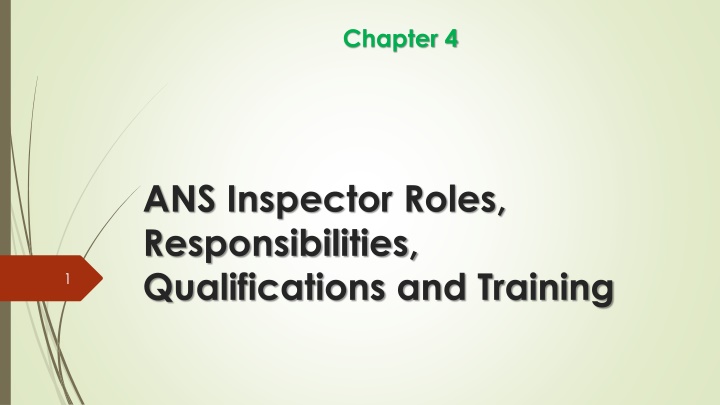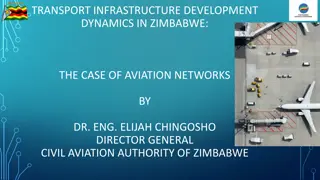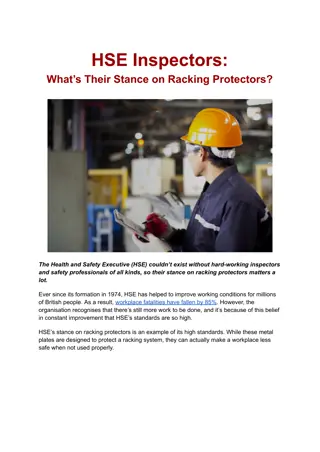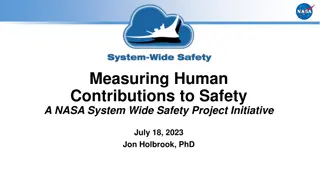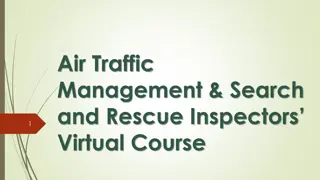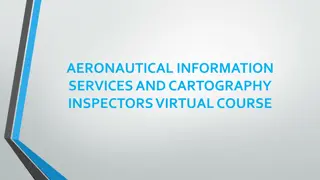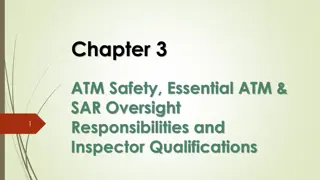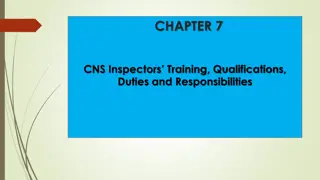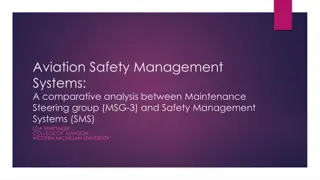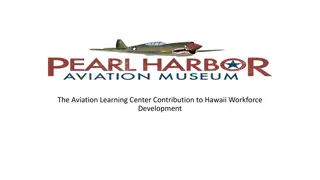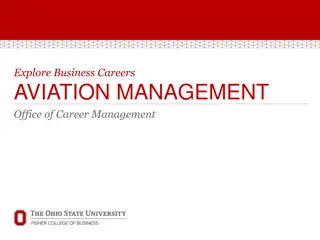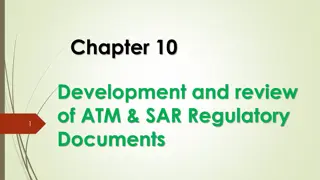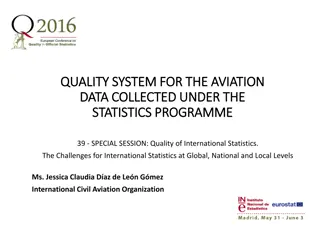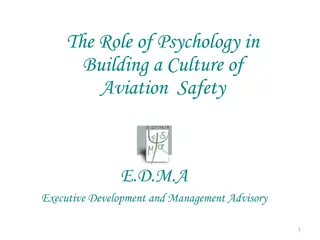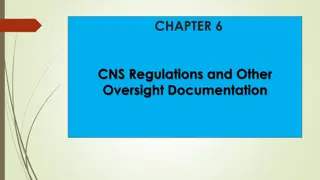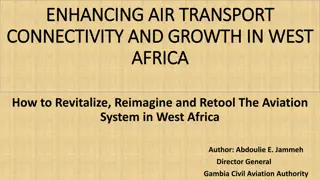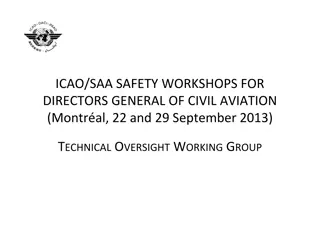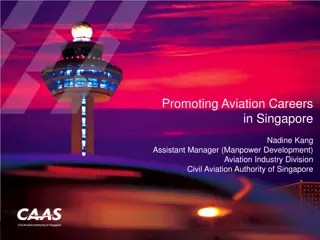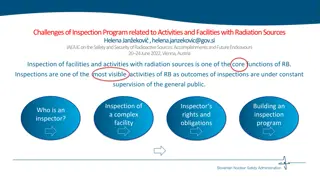Civil Aviation Safety Inspectors: Roles, Responsibilities, and Obligations
This chapter delves into the roles, responsibilities, and training needs of Civil Aviation Safety Inspectors (CASIs). It explores the importance of inspector training programs, State obligations to support an effective inspectorate, and the qualifications required for CASIs. The content emphasizes the critical elements of a State's safety oversight system and highlights the obligations of States towards international civil aviation.
Download Presentation

Please find below an Image/Link to download the presentation.
The content on the website is provided AS IS for your information and personal use only. It may not be sold, licensed, or shared on other websites without obtaining consent from the author.If you encounter any issues during the download, it is possible that the publisher has removed the file from their server.
You are allowed to download the files provided on this website for personal or commercial use, subject to the condition that they are used lawfully. All files are the property of their respective owners.
The content on the website is provided AS IS for your information and personal use only. It may not be sold, licensed, or shared on other websites without obtaining consent from the author.
E N D
Presentation Transcript
Chapter 4 ANS Inspector Roles, Responsibilities, Qualifications and Training 1
Objectives 2 At the end of this Chapter, the trainee should be able to; Identify inspector roles and responsibilities Identify the inspector training needs Explain the importance of training programmes/plans and keeping training records
References 3 Annex 19- Safety Management Doc 10070-Manual on the Competencies of Civil Aviation Safety Inspectors Doc 9734 Safety Oversight Manual: Part A The Establishment and Management of a State s Safety Oversight System; ICAO-USOAP Report 2015-2018
4 Chapter Content State/CAA Obligations to Support an Effective Inspectorate Inspectors Duties And Responsibilities Inspector Training, Qualifications and Credentials
5 Definition Civil aviation safety inspector (CASI)-A qualified person authorized by the State to carry out safety oversight activities for civil aviation. technical specialists traditionally recruited from those sectors of the aviation industry that they will eventually oversee, and who possess the appropriate technical qualifications and competencies Safety oversight is a function performed by a State to ensure that individuals and organizations performing an aviation activity comply with safety-related national laws and regulations.
State Obligations 6 There are two types of States obligations with regard to oversight: a) those that relate to supporting international civil aviation; and b) those that relate to supporting Civil Aviation Safety Inspectors (CASIs) to effectively perform safety oversight functions on behalf of the CAA. The Convention and its supporting nineteen Annexes established several key obligations for Contracting States. One of the obligations is oversight of various aviation entities and activities.
State Obligations continued . 7 To accomplish these obligations, a State must implement the CEs : The eight critical elements of a State safety oversight system
State Obligations continued 8 Critical element 4 is particularly related to the qualification of CASIs and the implementation of critical elements 6, 7 and 8. Of particular interest are the Standards associated to this critical element 4 in Annex 19, namely: CE-4 Qualified technical personnel: 1) The State shall establish minimum qualification requirements for the technical personnel performing safety oversight functions and provide for appropriate initial and recurrent training to maintain and enhance their competence at the desired level. 2) The State shall implement a system for the maintenance of training records.
State Obligations continued 9 CE- 5- The State shall provide appropriate facilities, comprehensive and up-to-date technical guidance material and procedures, safety-critical information, tools and equipment, and transportation means, as applicable, to the technical personnel to enable them to perform their safety oversight functions effectively and in accordance with established procedures in a standardized manner.
Establishment of CE-4 10 Reports of the Universal Safety Oversight Audit Programme and Continuous Monitoring Approach indicate that CE-4 remains one of the CEs with the lowest effective implementation (EI) rate at the global level. All CEs from CE-1 to CE-5 have seen an increase of their EI. However, all CEs related to the actual implementation of the State s safety oversight system, i.e. CE-6, CE-7 and CE-8, have seen a decrease of their EI
Establishment of CE-4 11 Global rate of effective implementation of the eight critical elements
Establishment of CE-4 14 Kenya
Establishment of CE-4 15 Challenges ? CAAs not sufficiently staffed to effectively perform all necessary additional certification, surveillance and enforcement activities associated with a significant increase of their level of aviation activity. States not able to retain some of its qualified and experienced technical staff. The lack of or insufficient number of qualified inspectors remains the main obstacle to the implementation of an effective State safety oversight system, and is often the root cause of situations leading to the identification of Significant Safety Concerns (SSC) in the States by ICAO.
Establishment of CE-4 16 Challenges ? States cannot objectively estimate the CAA s staffing needs in the various aviation domains, based on the State s level of activity and complexity of the aviation system, as well as to estimate, obtain and train additional human resources when a significant increase in the State s level of aviation activity is observed or forecasted. See Handout States have not yet established training policies. Lack of sufficient funds for the effective implementation of the training programmes
Establishment of CE-4 17 Challenges ? Training policy exists but is not comprehensive or appropriately implemented, States lack or have insufficiently detailed training programmes for some or all of the CAA inspector positions; Training records not well maintained; The on-the-job training (OJT) may not be performed by sufficiently qualified and experienced staff and/or may not be documented in the training records; and Lack of sufficient financial resources remains the main obstacle to the provision of training, which results in the inspectorate and relevant staff not having the necessary qualifications.
CAA Obligations to Support in Effective Inspectorate States must establish conditions that allow Civil Aviation Safety Inspectors(CASIs) to discharge their duties. This requires the State to delegate specific powers of authority to CASIs supporting the accomplishment of their tasks. Some States codify the CASI s power of authority and degree of accountability into aviation law to enable CASIs to effectively carry out their assignments. Creating the conditions that allow CASIs to discharge their duties also requires the DGCA to: establish clear and comprehensive workplace policies and procedures; provide a safe working environment; and supply CASIs with adequate workplace resources. 18
Policy and Procedures (ANS Inspector Handbook) 19 The CAA must have comprehensive documented policies and procedures which establish expected standards of service for all inspector-related tasks. Policies and procedures should at least explain departmental values, codes of conduct, operational procedures, and internal reporting and record keeping requirements.
Policy and Procedures (ANS Inspector Handbook) 20 ICAO guidance related to these operational procedures to help CAAs develop their own inspector guides can be found in ICAO DOC 10070; Appendix C. CAAs should customize them to ensure that they are consistent with State regulatory requirements and CAA procedures. These can be incorporated in the ANS inspector handbook. A CAA training policy should clearly address the initial training of CASIs, as well as the periodic recurrent and specialized training necessary for CASIs to perform the tasks for which they are responsible.
Workspace and Equipment 21 Inspectors and supporting staff should have suitable workspaces in CAA offices. Inspectors and stakeholders should have access to a sufficient number of meeting rooms. Inspector workspaces should be in a secure area of the building that does not permit access to non-authorized visitors to ensure confidential information is not compromised. Security arrangements should also apply for the record keeping area of the CAA
Safe Working Environment 22 The day-to-day operation of an inspectorate involves the provision of civil aviation regulatory services to a law-abiding community. However, there will be occasions when some entities will willfully attempt to operate outside the regulatory boundaries. For this reason, CAAs should have adequate security procedures in place, Although not a frequent occurrence, inspector s field work can put the individual in harm s way. In particular, the CAA should manage with due care surveillance activity at remote locations.
Safe Working Environment continues 23 Much of an inspector s workload involves field work, the CAA should issue each CASI with sufficient equipment to effectively function away from the office. CASI should have easy access to all applicable CAA rules and guidance material while in the field. At the very least, there arrangements so that inspectors are able to obtain specific details of a regulatory provision and/or consult with subject- matter experts (SMEs) while outside the office. For enhanced security, CAAs may provide credentials with embedded biometric data to prevent unauthorized entry to restricted areas by holders of forged documents. should be communication
Remuneration, Conditions of Service and Staffing As stated in Annex 19: States shall take necessary measures, such as remuneration and conditions of service, to ensure that qualified personnel performing safety oversight functions are recruited and retained. States shall ensure that personnel performing safety oversight functions are provided with guidance that addresses ethics, personal conduct and the avoidance of actual or perceived conflicts of interest in the performance of official duties. The Safety Oversight Manual (Doc 9734), further indicates that CASIs should enjoy remuneration and conditions of service consistent with their education, technical knowledge and experience and comparable to the industry staff whose activities they will inspect and supervise. 24
Inspectors Duties and Responsibilities 25 Principal duty Focuses on inspection, certification and on-going surveillance. Job Purpose of the ANS Inspector Responsible for the planning, organizing and carrying out oversight of Air Navigation Services as guided by provisions of the Chicago convention, International Civil Aviation Organization (ICAO) annexes, PANS, the Civil Aviation Act and applicable State regulations and standards to enable achievement of the required compliance, enhance air safety and attain efficiency of the air transport sector.
Inspectors Duties and Responsibilities 26 The lists of duties reported below are to be considered non- exhaustive, as they largely depend on the internal organization of the CAA and on the size of the regulated industry. The management of remediation (corrective actions)and enforcement are critical duties of CASIs and inspection teams. Depending on the scope of their delegated authority, CASIs will have varying levels of responsibility regarding remediation and enforcement. While all CASIs will address remediation in some shape or form, not all CASIs will address enforcement.
ANS Inspector Duties 27 Oversight of air traffic services providers, including acceptance of their SMS; Oversight of meteorological services; Oversight of aeronautical information service providers and their management of information; Oversight of the communication, navigation and surveillance (CNS) infrastructure and its effectiveness; Approval of airspace structure changes and flight procedures conceived by a design organization;
ANS Inspector Duties Cont. 28 Oversight of search and rescue coordination; Approval of ANS training organizations and programmes; Qualification and approval of ANS simulation training devices; and Assessment of applicants for an air traffic controller license or rating (or equivalent qualification).
ANS Inspector Specific Duties 29 Conducting inspections, audits and surveillance of Air Navigation Services to ensure continued compliance with applicable ICAO standards, procedures and state regulations; Recommending enforcement action with regard to non- compliances to provisions of ICAO standards and procedures, legislation and state regulations; Development and review of ANS Regulations Development and review of Technical Guidance Material (TGMs), manuals and procedures
ANS Inspector Specific Duties 30 Preparation of ANS inspection/audit reports following inspections and surveillance activities Generation of Corrective Action Requests (CAR) for non- conformances Reviewing of Corrective Action plans for approval Tracking of the implementation within acceptable timelines of Corrective Action plans (CAPs) Evaluation of manuals, operations procedures and other documents submitted by the service provider for approval and/or acceptance Implementation of all ICAO USOAP activities
Inspector Training, Qualifications and Credentials 31 Introduction The training objective is to provide the ANS Inspector with basic knowledge which will enable them perform the ANS regulatory functions. The knowledge is acquired through a combination of formal training courses and on- the-job training.
Types of Training 32 Initial training Indoctrination Some recommended training courses that need to be undertaken by ANS Inspector include: a) ANS Inspector Course, b) Auditing Techniques c) Enforcement and Compliance Procedures Course, d) SMS e) SSP f) OJT including administrative procedures and a minimum of three inspections with a qualified ANSI. g) Communications Skills, , h) Report Writing Skills
Specialized training 33 The specialized training shall be dependent on the different ANS fields of inspection i.e. ATM, CNS, AIS, and SAR and MET; a) PANS-OPS Course, b) Human Factors, c) Safety Management and Investigation Course, d) Accident and Incident Analysis Course e) Quality Management Systems f) Management Courses, g) Safety Oversight for Managers h) USOAP/CMA Audit course i) Resolution of Safety Issues etc j) ICAO USOAP/CMA- ANS CBT
Other Training For ANS Inspector 34 Recurrent training All ANS Inspectors shall be required to undertake recurrent training periodically. Training for re-qualification An Inspector who has been out of the programme for more than one year: a) Shall undertake a recurrent training, and b) Conduct at least two inspections accompanied by a lead Inspector
On-job-training(OJT) 35 All ANS Inspector candidates shall undergo OJT under the supervision of a qualified ANS Inspector. The candidate must, a) participate in at least two inspections conducted by a qualified ANS Inspector as an observer and; b) conduct at least three independent inspections under the supervision of an experienced and credentialed ANS Inspector
On-job-training(OJT) 36 ANS INSPECTOR OJT LEVEL I Introduction to the structure of the CAA as whole and the regulatory functions/ICAO Safety Oversight Introduction to the National Regulatory framework related to the ANS oversight (powers and duties from the civil aviation act and the ANS Regulations). Development and amendment/updating/review of ANS regulations Development and maintenance of the MANS-OPS and monitoring of ICAO annex amendments Introduction to the technical guidance material on the ANSP Oversight/ICAO Tools Advisory circulars/orders Inspector s handbook Checklists ICAO Compliance Checklists ICAO ANS PQs ICAO SAAQs Overview of the development and amendment/ updating/ review of the TGM (ACs, ANS Inspectors handbook, Checklists, orders etc) Identification of deficiencies Follow-up of deficienies
On-job-training(OJT) 37 ANS INSPECTOR OJT LEVEL I Review of the process followed to certify an ANSP. Approval of the MANS-OPS Development and maintenance of the ANS Technical Standards, MANS-OPS and monitoring of ICAO annex amendments Audit/inspection program/plan Audit/inspection types Audit/inspection procedures. Pre inspection Physical inspection Post inspection Follow-up Report writing
On-job-training(OJT) 38 ANS INSPECTOR OJT LEVEL II Practical audit conducted while the trainee observes the process Completion of Inspection Checklists Completion of Inspection Reports and Corrective Action Requests(CARs) The trainees to conduct 2 solo audits under supervision Completion of the Audit/Inspection checklists, Reports and Corrective Action Requests(CARs) Evaluation of CAPS, Tracking of CAPS, Closure of CAPS LEVEL III
Training plan and Training records 39 The CAA shall ensure that a training plan is prepared and implemented in every Calendar year and ANS Inspector/Auditor are trained in the relevant special courses. The CAA shall keep all the training records of all Inspectors/Auditors.
Qualifications 40 The satisfactory execution of the various functions of the CAA inspectorate depends on the qualifications, experience, competence and dedication of individual inspectors Considering the specialized and sensitive nature of the CAA inspector's mission, it is essential that the qualifications, previous experience and personal characteristics of each person to be employed to perform inspection and oversight duties be verified and carefully evaluated before selections and appointments are made. Inspectors can be called upon to act as an observer, analyst, investigator, auditor, mediator, negotiator, technical expert, judge or even as a witness
Qualifications 41 The air navigation services inspector applicant should hold or have held the relevant licenses/ratings/certification(or equivalent qualification) and have relevant experience in the duties assigned by the CAA. Degree in relevant field Necessary ratings Equipment training Relevant experience
Inspector Credentials 42 The ANSI s credentials will identify the bearer as an accredited representative of the Authority authorized to perform ANS Inspections/audits and discharge those duties as provided for by the CAA Approval Authority The DGCA is the approving authority for issuance of ANS Inspector credentials. Responsibility The CAA is responsible for establishing the criteria for eligibility, issuance and accountability of ANS Inspector credentials. The procedures for issuance and control of credentials. Use of Credentials a) The credentials shall be used only in the conduct of official business b) Holders of credentials are responsible for their proper safekeeping at all times c) Misuse or improper possession of the credentials can subject the offender to disciplinary action.
Loss of credentials and Surrender of Credentials 43 Loss of credentials The ANS Inspector s credential is the property of the Authority. If a credential is lost, the office of the Civil Aviation Security shall be notified immediately. Surrender of Credentials The ANS Inspector s credentials shall be surrendered to the holder s supervisor under any of the following conditions: a)Termination of employment; b)Reassignment to a position which does not require an ANSI credential; c)Issuance of a revised credential; or d)Upon demand of the issuing authority
SUMMARY 44 State Obligations CAA Obligations to Support an Effective Inspectorate Inspector s Duties And Responsibilities Inspector Training, Qualifications and Credentials
End Of Chapter Thank you 45
